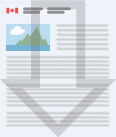The Canadian Food Inspection Agency (CFIA) regulates the humane treatment of all animals being transported into, within, and out of Canada by enforcing the Health of Animals Regulations (Part XII) Transport of Animals.
All persons involved in the transport of animals must ensure that every animal being transported is assessed as being fit for the intended trip and that all provisions of the regulations are met.
Unfit animals (as described in the Regulations) are not to be transported unless it is to receive care recommended by a veterinarian. If transported, they must be loaded, confined, transported and unloaded in accordance with the provisions of the Regulations (refer to section 139(2)) to prevent suffering, injury or death. Compromised animals (as described in the Regulations) are not to be transported to assembly centres, including auction markets. They may be transported if they are isolated from other animals, are loaded and unloaded individually without having to negotiate any ramps within the conveyance, and transported to the nearest suitable place where they can receive care or be humanely killed. They must also be provided with feed, water and rest at a maximum, every 12 hours (fewer if needed to meet required outcomes). They must be loaded, confined, transported and unloaded in accordance with the provisions of the Regulations (refer to section 140(1)) to prevent suffering, injury and death.
If an animal becomes unfit or compromised during transport, reasonable measures must be taken to prevent unnecessary suffering. The animal must be transported to the nearest suitable place where it can receive care, be humanely killed, or humanely kill in place
Signs of an unfit animal
- is non-ambulatory
- has a fracture that impedes mobility or causes signs of pain
- presents with lameness including signs of pain and halted movement, or cannot walk on all of its legs
- is in shock or is dying
- has a prolapsed uterus
- has a severe rectal or severe vaginal prolapse
- has nervous system disorder
- is a porcine that is trembling, discolored and has difficulty breathing
- has laboured breathing
- has severe open wound or severe laceration
- is hobbled to aid in treatment
- is extremely thin
- exhibits signs of dehydration
- is hypothermic or hyperthermic
- exhibits signs of a fever
- has a significant hernia that impedes movement, causes signs of pain, touches the ground when standing, or that has an open wound or infection
- is in the last 10% of its gestation period or has given birth during the preceding 48 hours
- has an unhealed or infected navel
- has a gangrenous udder
- has severe cancer eye
- is bloated with signs of discomfort or weakness
- is exhausted
- exhibits any other signs of infirmity, illness, injury or a condition that indicates that it cannot be transported without suffering
Signs of a compromised animal
- is bloated but does not demonstrate signs of discomfort or weakness
- has acute frostbite
- is blind in both eyes
- has not healed after any procedure, including dehorning, castration, and detusking
- lameness other than what is described in the regulation as unfit
- has a deformity or a fully healed amputation that does not cause pain
- is in a period of peak lactation and will not be milked to prevent mammary engorgement
- has an unhealed or acutely injured penis
- has a minor rectal or minor vaginal prolapse
- has its mobility limited by a device, other than for treatment
- is a wet bird
- exhibits any other signs of infirmity, illness, injury or of a condition that indicates that it has a reduced capacity to withstand transport
Note
- Calves 8 days and under are prohibited from being transported to assembly centres, including auction markets.
- Lactating animals that cannot be milked to prevent engorgement must reach a destination where they can be milked or slaughtered before becoming engorged.
- Animals with mammary engorgement will be considered unfit.
All regulated parties are required to be aware of all applicable provisions in Part XII of the regulations.
Learn more about humane transport and animal welfare.
